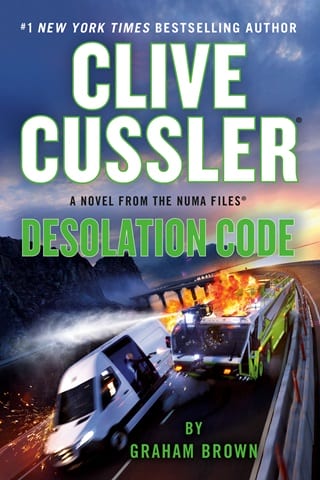Chapter 13
On the tenth floor of the NUMA headquarters building in Washington, D.C., Hiram Yaeger stared at a pair of computer screens. On one he saw Kurt, Joe, and the Trouts using a videoconferencing app similar to FaceTime or Zoom. On the other was a screenshot of the latest text message Kurt had received. Yaeger found himself perplexed by the mysterious note.
Hiram Yaeger was NUMA’s director of technology. He’d been designing and building computers since he was a teenager, back when the printers were dot matrix and the screens were green and black cathode ray tubes. In the decades since then, he’d amassed nearly a hundred patents, been paid a small fortune in royalties from companies licensing his technology, and had become a fixture at NUMA, where he’d constructed one of the most powerful computers in the world, named Max. He was not the type to be flummoxed by a crank caller or spam message.
“Can you send us the actual message?” Yaeger asked.
“Sorry,” Kurt said. “In true cloak-and-dagger fashion, they self-destruct seconds after I receive them.”
“At least they didn’t blow up,” Yaeger joked.
Kurt appreciated the quip. But he was too focused on getting answers to offer a laugh. “Any idea how they got here in the first place?”
“They have to be reaching you via our satellite network,” Yaeger said. “Max, can you check the operational data and find out where this message came from and how it’s getting through our filters?”
Max was Hiram’s masterwork, a supercomputer that used a unique coding language he’d designed himself. That language, along with other design features Yaeger had perfected, made Max a one-of-a-kind machine, virtually impervious to hacking, since only Hiram and Max herself knew the coding language he’d used.
“I’ve already looked into it,” Max replied in a sultry female voice.
While computers didn’t technically have gender—at least not yet—Hiram had chosen to give Max a voice that sounded like his wife’s. An earlier version of the program included a shapely hologram that also resembled Mrs. Yaeger, though Hiram had deleted that program from the operating system at his wife’s request.
“Ahead of the game as usual,” Yaeger said smugly. “What have you found?”
“There’s no record of the message passing through any of the servers or being transmitted by the encrypted communication system,” Max said. “Tiny errors in time coding indicate a sophisticated program was used to enter the message in our system, transmit, and then erase both the message and the path it took getting to Kurt.”
On-screen, Kurt appeared genuinely surprised. “Are you trying to tell me someone has outsmarted the two of you?”
“Looks that way,” Yaeger said.
“Temporarily,” Max insisted.
Kurt laughed. He knew it was just programming and highly complex algorithms, but he enjoyed teasing Max, who seemed to have a prickly ego at times.
“What about the numbers at the bottom?” Kurt asked. “I’m pretty sure those same numbers appeared on the other text, but they vanished before I could write them down. Do they mean anything?”
Hiram looked over the string of letters and numbers, agreeing with Kurt’s assessment that they resembled a product code or encryption key. He deferred to his computer. “Max?”
“Processing,” Max said. “Stand by.”
While Max crunched the numbers and compared the data to any known codes or encryption systems, Hiram turned back toward the text, considering the words. They were direct. Almost personal. Plaintive. Almost desperate. As if the sender was hoping to make Kurt feel or infer more than was being written. Then again, that’s how hackers worked. Get someone to think they know you and they were more likely to reply.
With Max still working on the string of symbols, Hiram decided to tap into Kurt’s human intuition, an instinct that couldn’t be more antithetical to the work Max was doing. “What do you think? What’s your gut telling you?”
“Initially I thought it was a prank or a glitch,” Kurt said. “But the technical hurdles someone would have to overcome to get these messages through to my phone make me think it’s more than that.”
“A sound analysis,” Max chimed in.
So instinct and computing power concurred. Hiram liked when things worked out that way. He asked Kurt another question. “Any hunch who these ‘children’ are?”
“No,” Kurt said. “The first message suggested something coming our way and that their fate was in my hands. When the stranding began I thought the sender might be referring to that. At the very least, the timing was suspicious. But now it seems like it’s something else . If it’s anything, that is . ”
“Speaking of anything,” Yaeger said, a tiny hint of frustration in his voice. “Have you found anything , Max?”
Max replied curtly. “I’ve checked the string of symbols against two million known forms of code. It corresponds to none of them. Using standard code-breaking techniques, I’ve analyzed the numerical and alphabetical sections independently and in conjunction. The result is null. Nothing to indicate it was a coded message. Though the sample size is so small, it’s not impossible for that to be the case.”
“What if it’s not in code?” Kurt asked. “We’re assuming it’s something encrypted, because the letters and numbers don’t give us anything we recognize, but why would someone send half a message in plain text and the rest in code? Especially if that message is going to erase itself as soon as it’s viewed.”
“One point for intuition,” Hiram said. “Max?”
“Stand by.”
Hiram grinned. He’d continued to enhance Max’s speed and power over the years. As a result, Max became full of herself at times. Being outthought occasionally helped cut her down to size. “Kurt, you may have stumped the computer.”
“I was asked to examine the text for code, not other possibilities,” Max insisted.
“So it’s our fault,” Hiram replied.
“I would have thought that much was obvious,” Max said.
Kurt chuckled. So much for reining in Max’s ego.
“Pattern match detected,” Max said. “Correlation: one hundred percent. The alphanumeric string is associated directly with a NUMA-issued tracking beacon.”
Yaeger’s eyes grew wide.
On-screen, Kurt looked surprised as well. “Are you sure?”
“The first half of the letter string is an internal product number connected with our standard sixty-day sea-life tracking beacon,” Max said. “The very type you and Joe have been using during your shark study. The second set of letters denotes a specific beacon identifier, which allows you to differentiate which shark or aquatic animal is being tracked.”
“Where is this beacon right now?” Kurt asked.
“Sitting in a warehouse in Monroe Township, New Jersey.”
The air came out of the conversation. Hiram tried—and failed—to think of a way to pump it back in.
Kurt’s voice broke the silence, but he wasn’t talking to Max or Hiram. “Look it up anyway.”
“Why?”
“Whoever sent this message wanted me to find someone,” Kurt explained. “He or she gave us an authentic radio tag number to use for that purpose. Maybe that beacon is sitting in New Jersey, where it’s supposed to be, and maybe it isn’t. The only way to find out for sure is to check its reporting history. Look it up. Ping the beacon.”
Max did the work, linking into the satellite network and issuing a request for the beacon to respond and deliver all stored data. The initial report said the beacon was offline or hidden somewhere at the current moment, but a significant number of data points that had been reported over the last forty-eight hours appeared.
Yaeger stared. “Well, I’ll be damned.”
Max brought up a map that displayed the Indian Ocean, including Reunion Island, Madagascar, and the coast of Africa. A thin blue line appeared in the middle of the map, about two hundred miles northeast of Reunion. It meandered slowly west and south for the better part of two days, then turned due north, picking up speed to fifteen knots and holding a true course until it stopped reporting several hours later.
“The initial path is odd and slow,” Yaeger said.
“Wind drift,” Kurt said. “With a slight boost from the current bending the course to the south. I’d guess the beacon was in the water, or it’s attached to a boat with no propulsion.”
Behind Kurt, Joe spoke up. “It hit the right area,” he said. “But it turned north, a few hours before the sharks started their stampede.”
“Maybe whatever spooked the sea life sent our beacon holder fleeing in the other direction,” Yaeger suggested.
Kurt shook his head. “The time doesn’t match up. And assuming whoever had this beacon was trying to reach us, why bother drifting on the wind for two days if you had a motor that could do fifteen knots?”
Joe chimed in again. “And why would you head north once you did get that engine going?”
“Max,” Kurt said. “Can you pull up a chart of the shipping lanes and overlay it on the map?”
“Of course I can,” Max replied. “Are you asking me to?”
“With sugar on top,” Kurt said.
“Sugar is a destructive carbohydrate,” Max said. “Unlike humans, I don’t require such fuel. But thanks for the offer.”
Max then brought up a new map, merging it with the tracking data. The main shipping lane up from South Africa crossed directly through the area in question.
Yaeger summed up what everyone now realized. “Whoever had this beacon didn’t suddenly turn their motor on. They got picked up by a passing ship. That’s why they suddenly changed course and speed.”
“Okay, but which one?” Joe asked out loud. “That’s a heavily traveled route.”
Max had already looked up the AIS data for ships transiting the area. “A tanker named Soufriere made a transit of those waters at precisely the same time as the change in the beacon’s course and velocity. It’s the only match.”
On-screen, Yaeger saw Kurt grinning. “Outstanding,” he announced. “Where’s it headed?”
Max accessed the data and displayed it on Yaeger’s screen, leaving it to him to deliver the bad news. “You’re not going to like this,” Hiram said finally. “The Soufriere is on its way to the breakers. It’s marked to be broken down for scrap on the beach at Alang, India.”
“That’s not good,” Kurt said. “When is she scheduled to arrive?”
Max replied. “AIS data shows her already in the bay, waiting to be run aground.”
In the hotel room in Saint-Denis, Kurt found himself torn. He wanted to go search for the cause of the mass stranding. A task that he expected would be dangerous, considering the lengths someone had already gone through to cover up that cause. On the other hand, it seemed impossible that the text messages could be a prank.
Normally one to go on a hunch, he decided some statistical analysis might help. “Max,” he said. “What is your analysis of the texter’s method of communication, choice of words, and lack of detail? In other words, why all the cloak-and-dagger? Why not just tell us what he or she wants and who he or she is?”
“No conclusion possible,” Max admitted. “But the pattern is suggestive of a party attempting to communicate surreptitiously. Whoever it is, they’ve taken substantial and highly technical steps to avoid detection. Had you not taken the screenshot of the image, even I would have been unable to find a trace of the information on your phone. The vague phrasing also supports this conclusion. As if the sender is relying on the human ability to infer information that isn’t present in the actual text, hoping you can read between the lines, so to speak. That makes it something of a code. A human code.”
That made sense to Kurt, and considering the mystery person was obviously familiar with NUMA and the work he and Joe were doing, he found it impossible to believe it was a prank.
“What’s the probability of these events being related?” he asked.
“Impossible to determine with any accuracy,” Max said. “But the timing and location of the stranding and the beacon’s track suggests it’s more likely than not.”
“You’d be a good gambler,” Kurt said, complimenting Max.
He turned to Paul and Gamay. “I think we need to follow both leads. Joe and I will head to India and try intercepting the tanker. Can you handle the waterborne search for the cause of the stranding?”
“That’s why we came here,” Gamay said.
“Be careful. You’re looking for an answer that someone doesn’t want you to find.”
Gamay offered a knowing smirk. “Don’t kid yourself,” she replied. “So are you.”
 Fullepub
Fullepub 



